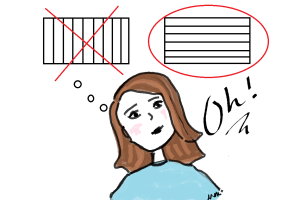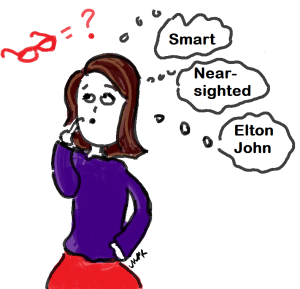I Framed It Wrong
For the last two weeks my dad and I have been at my lake-lot building a cedar deck and staircase down to the water. It has been both a joy working with side-by-side with my good-natured father and an education in carpentry and patience. It has also reminded me about how easy it is to make mistakes in our perception.
A little backstory: our project design exists exclusively in my dad’s (very experienced) mind. With each phase, dad will stand over the project and measure, jot notes in pencil on a chunk of 2”x4”, then tell me how to help.
A few nights ago as we were finishing the stairs, dad pointed to three 2”x6”x8’ green-treated planks and said, “Over the next few days decide how you would like the lower deck.”
The next day I hauled the boards to the bottom of the staircase, and after tugging them this way and that, I centered them. Following lakeshore regulations, the deck could only be five feet wide at that location. “Perfect!” I thought. Figuring that the green-treated boards were the supports, I bought 12’ cedar planks to be cut into 5’ lengths to cover them, and I drove to my dad’s. When I opened the back of my van, my dad looked at the lumber perplexed. “Why did you buy these long boards?” he asked. I explained my thinking, and he said, “I thought we would buy 8’ planks and run them lengthwise to save on cuts.” He gives me a look. “We can buy more supports and cut them as well.”
Oh!
In my mind, because we had three green-treated planks for the foundation, we would need to run the cedar across the top perpendicularly. It DID NOT occur to me that we would be cutting any of the planks. They were the length of the deck! I had framed the problem in one way and I COULD NOT SEE the other solution.
This reminded me of Dan Pink’s TED talk: The Puzzle of Motivation. He begins this talk with an example of Duncker’s “candle problem,” in which participants were tasked to attach a candle on the wall in such a way that the candle does not drip wax on a table using depicted items. (Watch this talk—it’s both a great example of the errors of perception and also how traditional incentives simply do not motivate people the way we hope they would). As you might guess, the participants perceived the problem based on how the items were depicted and could not immediately come to a solution. Functional fixedness, it is called. This is a problem of perception!
One of our challenges in life and communication is that our powers of perception are a lot less accurate than we believe them to be. In communication class we talk about the process of perception: how we select certain stimulation to pay attention to, we organize it our mind (like a file cabinet), and then we spit out an interpretation—all within milliseconds. Amazing, really! But think about the potential for error!
First, our sensory system is incapable of taking in all of the minute details of the present moment. This automatic filtering helps us survive in what would otherwise be an overstimulating world. But as a result, it greatly reduces the information we are able take in and work from.
And like I discussed in my post “the Nest: The Birthplace of Perception,” we are trained from infancy on what we should pay attention to and what things mean. We are given the mental structure to organize the experiences we have (e.g., “this situation is dangerous!” or “that kind of person is trustworthy.”) But these trainings are faulty. They are based on our care-givers interpretation of the world and our experiences up to this point. They are not necessarily accurate.
The take-away message here is this: how we initially perceive a situation is going to trigger our solution. Like in my deck project where I saw the green-treated lumber as remaining uncut and being used in one way, our initial interpretation leads us down a mental path that may not be the best solution.
This applies to people! When communicating with individuals, it is good to be aware of the mistakes we can make early in our perception process and question ourselves. Does this behavior really mean what I think it does? Did he/she intend to communicate that message, or am I receiving it based on my “lens?”
Our perceptive process is amazing in its efficiency in helping us interpret and survive our world. But sometimes it can hinder our ability to come to the best solution. Be wary of first impressions. Take extra time when it counts. Your communication and relationships will be better for it.



